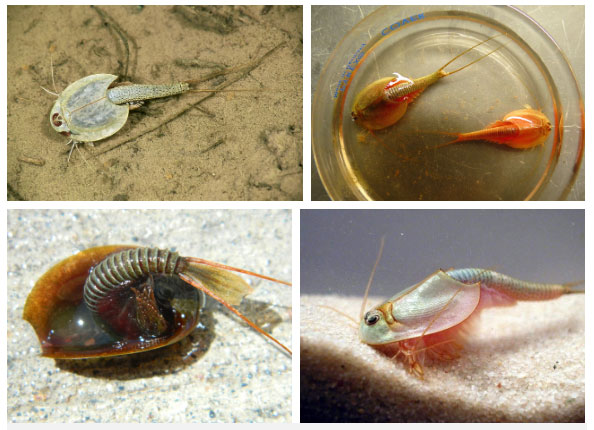The strange shrimp live in the desert: The oldest in the planet, 50 years without water and the eggs still hatch well
Just having a puddle of water in the hot sun in the desert is a tadpole. They grow super fast, only 2-3 weeks old.
Triops cancriformis (Triops cancriformis) is one of the oldest crustaceans on the planet. They may have coexisted with dinosaurs even 220 million years ago, and there is no need to evolve at all but still live well.
Good friend of . farmer
In fact, tadpoles are not only living in the desert. As an aquatic species, they are present in most freshwater environments from Europe to Asia.
It's easy to identify tadpoles, because they have a tail like a tail and a head of horseshoe. In captivity, tadpoles only grow to 6cm in size. However, in nature, they can reach 11cm in size.

This is tadpole.
The favorite of tadpoles is mosquito larvae. So they are considered to be human allies in the eradication of western Nile virus - the main virus that is transmitted through Culex mosquitoes.
In addition, tadpoles also eat weeds. In Japan, they are used by farmers as a biological solution to destroy weeds in rice fields.
"Reinforcing" eggs to 50 years later still hatch into children
When the Earth temperature in Ky Phan Trang (about 66 million years ago) began to heat up, the giant dinosaurs had only two paths: evolution to adapt to new climate conditions or die ( they eventually chose . to die.
But tadpoles don't have any trouble. Because they are one of the most strategic species to maintain the species. They have the ability to "reinforce" eggs for decades to smoothly hatch into children.

The favorite environment of tadpoles is temporary puddles.
Tilapia shrimp possess both forms of mono and bisexual reproduction . Their eggs are super hard, can withstand harsh conditions, whether hot, freezing or lack of oxygen.
By releasing trehalose - a water-repellent sugar , tadpoles keep their eggs safe in the water. If the habitat is not depleted, the egg will hatch into a child, continuing its life cycle. On the contrary, they will maintain their state until they meet the right conditions.
In the desert, tadpole eggs are like an armored device. Even when "roasted" under the 98 degrees Celsius heat, they can still withstand up to 16 hours of pink copper. The familiar 40-50 degree Celsius does not affect anything.

Although it took 50 years to meet the water supply, tadpole eggs were still "alive".
Especially, even if you have to wait for 50 years to meet the water supply, tadpole eggs still "live". It is through this persistent ability that, despite the desert's hot, dry conditions, patiently waiting for the rain to fall and the pond temporarily appears.
Amazing growth rate: 2-3 weeks has become "adult"
Just peeling the shell, the tadpoles are extremely busy. They catch every smaller creature in sight, at least "stuffing" a day with 40% of the body.
Thanks to omnivores and gnawing, they grow as fast as blows. Although it was only 1.8mm long at the time of birth, they were 6.4mm over the next 4 days. In about 2-3 weeks, tadpoles are mature, ready for reproduction.
Before the dry "temporary" house , tadpoles will attempt to lay as many litters as possible. Their eggs can hatch on the spot next year, when enough water can be scattered.

Large tadpoles are very fast, only 2-3 weeks ready for delivery.
No matter where you are trapped, just meet the right conditions, the tadpole eggs hatch into a baby. The newly born "smelly" are frantically pursuing the larvae, even fry and devouring the chewing of weeds.
- Found the world's oldest living fossils
- Detecting tadpole originated 200 million years
- 'Shock' discovered the first female shrimp, the 'adventure' is as magical as the fairy
- Shrimp species can live in hot water of 450 degrees Celsius
- Shrimp 'living fossils' resemble revived alien creatures
- Strange fasting fish to hatch eggs in the mouth
- The tiger bird - The silver mother and the killer child
- Many deserts ... water
- Shrimp escaped death thanks to green
- Dinosaurs hatch eggs on hot water circuits
- The shrimp are imprisoned for a lifetime in a protective cage
- 'Strange' work of doctor shrimp
- What few people know about the number of chicken eggs we still eat every day
- Hatching birds with electronic eggs
 Animal 'suffering' after hibernation
Animal 'suffering' after hibernation Why do goats climb well?
Why do goats climb well? Scientists were surprised to see chimpanzees eating turtles
Scientists were surprised to see chimpanzees eating turtles Giant catfish died deadly due to drought in Thailand
Giant catfish died deadly due to drought in Thailand